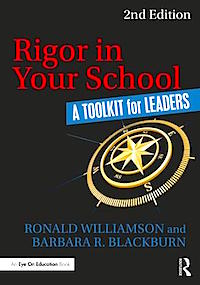Collaborating Through Shared Decision-Making
 By Ronald Williamson and Barbara Blackburn
By Ronald Williamson and Barbara Blackburn
The days of the solitary school leader disappeared decades ago. But leaders still struggle with how to involve others in decision-making and how to build a viable and successful shared decision-making model.
Professional collaboration is critical to the success of any school. The evidence indicates that decisions are better, have greater support, and are more likely to be implemented if they are the result of intentional collaboration with teachers, staff and parents.
In every school you can find examples of involvement in decision-making. Sometimes it is systematic, intentional and deals with vital curricular and instructional issues. Other times it’s simply a way for the principal to ask about managerial concerns.
There is no formula or perfect method for shared decision-making; however, it is most successful when the involvement is authentic, timely and a routine part of the school’s operations.
Examples of Teacher Involvement in Decision-making
Professional Learning Committee: Teachers on the committee review applications from teachers to attend conferences and make recommendations and decisions about approved conference travel. They provide substantive advice and feedback about school-based PD opportunities, as well.
School Improvement Committee: Teachers and parents work with the principal to set school priorities, determine improvement projects, and allocate resources.
Principal’s Advisory Committee: This group provides the principal with advice about important decisions. They serve as a sounding board for both day-to-day routines and important policy changes.
Scheduling Work Group: Many principals ask teachers, or department chairs in high schools, to work with them to determine the school’s schedule and teaching assignments.
Budget Review Committee: Some principals share information about the school’s budget with teachers and work with a small group to make decisions about spending priorities.
Benefits and Challenges
There are many benefits of shared decision-making:
►Higher-quality decisions because more perspectives are considered
► Increased job satisfaction and morale
►Heightened sense of empowerment
► Greater ownership of school goals and priorities when participants have a stake in the decision
► Improved student achievement because of greater coordination of work among teachers
Shared decision-making can also present challenges, including the following:
► Expanded participation may require more time to make decisions
► Group dynamics may stifle ideas, leading to “groupthink”
► Polarization can occur around specific points of view
► People feeling left out or that some have greater access and opportunity to influence decisions
It’s possible to overcome each of these potential obstacles. When it comes to time, leaders have to weigh the slower decision process against the benefits that come from setting aside time for discussion and analysis of alternatives. Promising discussion and then failing to allow adequate time to address an issue is never a good idea.
The dynamics of groups can be an issue but one that can also be addressed. The most successful collaborative groups develop their own norms for how the group will function and how they will make a decision. In addition to a decision-making model, norms often include things like how to involve everyone in the discussion, how to avoid distractions, and how to record and share decisions that were made.
Garmston and Wellman’s Norms of Collaboration (2013) can serve as a model, but most groups tailor it to their own needs or develop their own. Be sure to adopt a decision-making model before you need to make a decision. Once a group in a Chicago area middle school established their meeting norms, they posted them in the room where they met, and reviewed them at the beginning of every meeting.
A related issue is polarization that can occur around specific points of view. Successful groups welcome diverse perspectives but recognize the importance of establishing norms around discussion, use of data or expertise, and personal opinion. One middle school in suburban Phoenix established a norm that when speaking to an issue you could not cite your own “experience.” Individuals needed to cite research or guidance from a professional organization. That limited the use of phrases like “in my 30 years I’ve found. . .”
Finally, people who feel left out or believe that others have greater access and opportunity to influence decisions can create tension. An inclusive group that represents all factions of a school community is critical, as is a design that allows for rotating representatives
Overall, the long-term benefits of shared decision-making outweigh the short-term obstacles. When teachers, staff and families are active partners in decisions about their school, they have more ownership of the school’s direction and a greater commitment to its success.
Planning for Shared Decision-making
The first step is to decide whom to involve. Ask yourself two questions.
- Who is most directly affected?
- How much can people contribute? What is their level of expertise?
You might also consider other factors in order to facilitate your decision. Hoy and Tarter (2008) have suggested that if people have a stake in the outcome and have some level of expertise, they should be involved. If people are indifferent to the outcome and have no expertise, no involvement is needed. Finally, if people are concerned with the outcome but lack expertise or have expertise but are indifferent, then they should have limited participation.
Things to Consider
► What is the task?
► Who has a stake in the decision?
► Who should appropriately be involved because of their expertise or their role?
► How will the group be organized?
► What are the group norms?
► How will the decision be made?
► What is the timeline for completion of the task?
Leadership Teams
One of the most common structures for shared decision-making is a School Leadership Team, sometimes called a School Site Council or a School Improvement Team. It is generally composed of some combination of administrators, teachers, families, staff, and community members. Depending on your state or district, there may be laws or guidelines that determine the composition of your team. Some middle school teams also include a role for student representatives.
As with any team, different points of view are important and add value to the decision-making process. However, in order to be most effective, principals should provide three structures to the group:
Structures for Effective Leadership Teams
- Establish norms of operation (how the group will function) and norms for decision-making.
- Be absolutely clear about the link to the school’s mission and the importance of advancing institutional goals.
- Develop and model thoughtful decision-making processes.
Depending on the specific needs of your school, you may have a variety of teams, such as instructional leadership teams or Principal’s Advisory Council. Decide which teams you need and how they will function within the overall decision-making structure.
Checklist for Formation of Shared Decision-making Teams
_______ Is the purpose clear? Is the role well defined?
_______ Is membership representative? Is membership appropriate to the task?
_______ Are there agreed upon norms for operation? For decision-making?
_______ Is there a mechanism to communicate with the larger school community? With other decision-making groups?
_______ What is the process for concluding the team’s work?
The bottom line is to be sure the purpose of each team is clear and the roles are plainly stated and well-defined.
Conclusion
Expectations for involvement in decision-making are the norm in almost every school and community. It’s evident that involving teachers, families and others can result in better decisions, decisions that are much more likely to be successfully implemented. But it’s critical to thoughtfully plan groups and provide time for them to get organized and establish norms that will guide their work.
References
Garmston, R. & Wellman, B. (2013). The adaptive school: A sourcebook for developing collaborative groups. Norwood, MA: Christopher-Gordon.
Hoy, W. & Tarter, C. (2008). Administrators solving the problems of practice: Decision-making concepts, cases and consequences (3rd ed.). Boston, MA: Pearson Education.
______________________________






































Involvement in the decision-making process is important and can be a very effective tool in any organization as this would help in assessing issues that may arrive.
When all stakeholders are involved in the decision-making process, it boosts the level of participation in carrying out the mission to achieve the end goals.